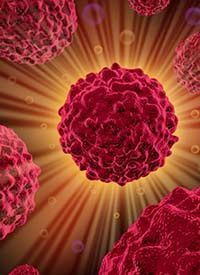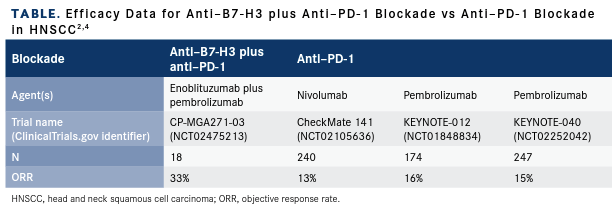Novel Combination Looks to Capitalize on Synergy of B7-H3/PD-1 Blockade
The investigational monoclonal antibody enoblituzumab has demonstrated activity in preclinical studies and in combination with pembrolizumab in phase 1/2 studies in patients with checkpoint inhibitor–naïve head and neck squamous cell carcinoma and non–small cell lung cancer.

Expression of B7-H3, a novel molecule of the B7 family, has been associated with undesirable treatment outcomes and has a potential role in the activation and inhibition of immune cell response.1 The investigational monoclonal antibody enoblituzumab has demonstrated activity in preclinical studies and in combination with pembrolizumab (Keytruda) in phase 1/2 studies in patients with checkpoint inhibitor–naïve head and neck squamous cell carcinoma (HNSCC) and non–small cell lung cancer (NSCLC).2
Investigators have demonstrated that more than 50% of patients across tumor types were positive for B7-H3 expression via immunohistochemistry. Specifically, for those with NSCLC (74% positive expression), B7-H3 correlated with ineffective anti–PD-1 therapy, and for those with cutaneous squamous cell carcinoma (85% positive expression), B7-H3 expression was higher in those who were immunocompetent.1
Patients with HNSCC who have relapsed or have metastatic disease have survival outcomes of approximately less than 1 year with the best available therapies.2 Activity has been observed with PD-1 inhibitors; however, investigators are pursuing synergistic pathways which may lead to improved outcomes with combination regimens.
Unpacking the Role of Enoblituzumab
B7-H3, also known as CD276, has limited expression in normal tissue, making it an attractive target for therapeutic development. Enoblituzumab is a fragment crystallizable (Fc) optimized humanized IgG1 monoclonal antibody with an antigen-binding fragment with a high affinity for B7-H3. Further, the Fc structure has a high affinity for activating CD16A and a low affinity for inhibiting CD32B, with the potential enhancement of adaptive immune responses.2
In a phase 1 study (NCT01391143) enoblituzumab had a tolerable safety profile with no drug-related adverse effects (AEs) that led to study discontinuation and no maximum tolerated dose was defined up to 15 mg/kg among patients with B7-H3 expressing cancers. Patients were heavily pretreated with a median of 3 prior lines of therapy (range, 0-7) and experienced disease stabilization over more than 12 weeks; tumor shrinkage ranged from 2% to 69% across tumor types.3
Efficacy data from the phase 1/2 CP-MGA271-03 study (NCT02475213) demonstrated that anti–B7-H3 and anti–PD-1 blockade with enoblituzumab and pembrolizumab nearly doubled overall response rates compared with anti–PD-1 blockade alone in comparator studies. Investigators enrolled patients with HNSCC, NSCLC, melanoma, and urothelial cancer to the study. In terms of safety, 27.1% of patients (N = 133) experienced grade 3 or higher AEs, the most common of which were infusion-related reactions (6.8%). An AE of special interest was pneumonitis, which was reported in 3.8% of patients with 2 patients having a grade 3 or higher event; pneumonitis led to death in 1 patient.4 Investigators noted that the AEs were consistent with previously reported data for the single agents.
Patients with HNSCC and NSCLC were stratified by those who received prior anti–PD-1/PD-L1 therapy and those who were treatment naïve. Among 18 treatment-naïve patients with HNSCC and were evaluable for response, 33.3% had a partial response or complete response vs no responses reported for the 19 patients who received prior anti–PD-1/PD-L1 therapy. Stable disease was reported in 27.8% and 47.9% of patients, respectively.
Among responders, 15 had B7-H3 expression of 10% or higher on tumor cells per immunohistochemistry. Among these individuals, 40.0% had a complete or partial response and 73.3% had a complete response, partial response, or stable disease at data cutoff.4
Investigators compared the response rate elicited with the combination in the treatment-naïve cohort with comparator studies and demonstrated that it was nearly double of that in those who received single-agent anti–PD-1 blockage alone (Table).2,4 Although the populations in the combination study were smaller, the efficacy data warrant further investigative efforts as a potential strategy to improve tumor responses.
Table. Efficacy Data for Anti–B7-H3 plus Anti–PD-1 Blockade vs Anti–PD-1 Blockade in HNSCC2,4

Combinations With Enoblituzumab Move Ahead
Investigators hypothesize that the simultaneous targeting of B7-H3 and PD-1 or B7-H3 and PD-1 and LAG3 may have the potential to sustain the immune activation and antitumor activity that is mediated by enoblituzumab based on in vitro data.
Therefore, the proof-of-concept phase 2 CP-MGA271-06 study (NCT04634825) was initiated to evaluate enoblituzumab in combination with retifanlimab or tebotelimab for the treatment of patients with recurrent or metastatic HNSCC not curable by local therapy with no prior systemic therapy for HNSCC in the recurrent or metastatic setting (Figure2,5).
Figure. Evaluation of B7-H3–Directed Therapy in HNSCC in CP-MGA271-06 Study2,5

Retifanlimab is an investigational, humanized, anti–PD-1 monoclonal antibody that binds to PD-1 with affinity 4 times greater than nivolumab (Opdivo) and 6 times greater than pembrolizumab.2,6 Tebotelimab is a bispecific DART molecule engineered against PD-1 and LAG3, disrupting the pathways that so that T-cell function may be restored. The agent blocks binding of PD-1 or PD-L1 to PD-1 as well as major histocompatibility complex class II to LAG3.2,7
Patients will be assessed for PD-L1 expression and stratified into cohorts based on combined positive score (CPS). Investigators plan to enroll approximately 50 patients with a CPS of 1 or higher to receive enoblituzumab at 15 mg/kg plus retifanlimab at 375 mg every 3 weeks for up to 35 cycles. Approximately 30 patients with a CPS of less than 1 will receive enoblituzumab at 15 mg/kg plus tebotelimab at 600 mg every 3 weeks for up to 35 cycles. Safety evaluations for dose-limiting toxicities will be conducted through day 7 of cycle 2 for the first 12 patients.2,5
The primary end point is objective response rate, with secondary end points of progression-free survival, disease control rate, duration of response, and overall survival. Exploratory objectives of the trial include relationships between pharmacokinetics, pharmacodynamics, safety, and antitumor activity; relationships between PD-1, PD-L1, B7-H3, and LAG3 expression on tumor cells and response; and peripheral biomarkers and correlation with potential clinical response.2
Patients whose primary tumor site is the upper esophagus, salivary gland, or nasopharynx of any histology or those with disease suitable for local therapy with curative intent are excluded from enrollment. Further, patients who have received prior therapy with an anti–B7-H3, anti–PD-1, anti-PD-L1, anti–PD-L2, or anti-LAG3 agent are not eligible.
The trial is open for enrollment.
References
- Yang S, Wei W, Zhao Q. B7-H3, a checkpoint molecule, as a tar-get for cancer immunotherapy. Int J Biol Sci. 2020;16(11):1767-1773. doi:10.7150/ijbs.41105
- Obara G, Sun J, Loo D, Bohac C. Phase II trial of enoblituzum-ab plus retifanlimab or tebotelimab in first-line treatment of patients with recurrent or metastatic head and neck squamous cell carcinoma (R/M SCCHN). Ann Oncol. 2021;32(suppl 5):S814. doi:10.1016/j.annonc.2021.08.1336
- Powderly J, Cote G, Flaherty K, et al. Interim results of an on-going phase I, dose escalation study of MGA271 (Fc-optimized humanized anti-B7-H3 monoclonal antibody) in patients with refractory B7-H3-expressing neoplasms or neoplasms whose vasculature expresses B7-H3. J Immunother Cancer. 2015;3(sup-pl 2):O8. doi:10.1186/2051-1426-3-S2-O8
- Aggarwal C, Joshua A, Ferris RL, et al. A phase 1, open-label, dose-escalation study of enoblituzumab in combination with pembrolizumab in patients with select solid tumors. Presented at: Society for Immunotherapy of Cancer Meeting 2018; November 7-11, 2018; Washington DC. Abstract O24.
- Enoblituzumab plus retifanlimab or tebotelimab in head and neck cancer. ClinicalTrials.gov. Updated October 12, 2021. Accessed November 11, 2021. https://clinicaltrials.gov/ct2/show/NCT04634825
- Retifanlimab (PD-1). MacroGenics. Accessed November 11, 2021. https://macrogenics.com/mga012-pd-1/7. Tebotelimab (PD-1 × LAG-3). MacroGenics. Accessed November 11, 2021. https://macrogenics.com/mgd013-pd-1-x-lag-3/




